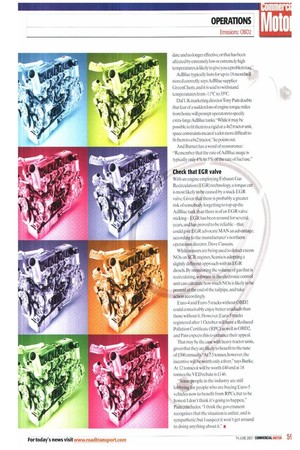EIVIISS NIPOSS ON BLE
Page 58

Page 59

If you've noticed an error in this article please click here to report it so we can fix it.
Tougher exhaust emission regs come into force
soon — Steve Banner finds out how the engine
manutacurers plan to clean up their acts.
No matter whether they meet Euro-4 or even Euro-5. trucks first registered after 1 October will have to be fitted with devices to detect emissions of nitrogen oxides (NOx) that fall too far outside the permitted parameters.
If the engine of a truck grossing 16 tonnes or above produces too much NOx a warning light will appear on the dash. If no action is taken and NOx output keeps rising, torque output will be cut by 40% the next time the vehicle stops, says Volvo UK legislation and environment manager Ray Cattley. Below 16 tonnes torque will be cut by 25%.
Iveco UK product director David Burke says:-In both cases the effect will be rather like having to use the limp-home facility on a semiautomatic gearbox," Instances of excess NOx sufficient to activate the warning light will be recorded by the detection equipment for downloading and analysis: data that will be available to the Vehicle and Operator Services Agency (Vosa). Ron Bowie, Volvo UK fleet engineering manager, explains:"The onboard unit logs any infringements for 4()0 days after they've occurred.The enforcement authorities can read them in a roadside check and there may be a prosecution if they are serious enough."
And such a conviction could have 0-licence implications, he warns.
The detection system is commonly referred to as On.Board Diagnostics 2 (OBD2)— reflecting the fact that a non-interventionist NOx diagnosis system is already in place on Euro-4 and Euro-5 trucks.
The regulations do allow engines a certain amount of leeway, according to Clive Burnet, Scania UK sales engineering manager:"So far as Euro-4 is concerned the legal NOx limit is 3.5 grammes per kilowatt-hour (kWh),but the warning is triggered and the event recorded only when it reaches 5g/kWh.You get a reduction in torque at 7g/kWh."
For Euro-5 these figures are 2g/kWh, 3.5g/kWh and 7g/kWh respectively, he adds.
Iveco is already fitting OBD2 to the Euro-5 Stralis ahead of the legislation. Other manufacturers arc installing it on all trucks now in build: Euro-4 as well as Euro-5.
Ahead of the law
"At Scania, we're making OBD2 standard on all trucks produced from 1 July," says Burnet. Iveco's Bowie reports:"We're offering it as a no-cost option,but it will be mandatory from mid-September onwards."
A derogation will give manufacturers until 30 September 2008 to register trucks built prior to 1 October 2007,according to the Department for Transport. However, this will be restricted to 30% of the manufacturer's registrations for the previous year or 100 vehicles, whichever is the greater.
The most likely cause of excess NOx from an engine using Selective Catalytic Reduction (SCR) technology will be an empty or almost empty AdBlue tank."Nine times out of 10 that will be the reason," Burke suggests.
Topping up the tank should solve the problem. unless it is the consequence of a defect elsewhere in the AdBlue system,such as a faulty pump.
Burnet warns:"AdBlue that's past its sell-by date and no longer effective,or that has been affected by extremely low or extremely high temperatures, is likely to give you a problem too.'' AdBlue typically lasts for up to 18 months if stored correctly says AdBlue supplier GreenChem, and it is said to withstand temperatures from -11°C to 35°C.
Daf UK marketing directorTony Pain doubts that fear of a sudden loss of engine torque miles from home will prompt operators to specify extra-large AdBlue tanks.'`While it may be possible to fit them to a rigid or a 4x2 tractor unit, space constraints mean it's a lot more difficult to fit them to a 6x2 tractor." he points out.
And Burnet has a word of reassurance: -Remember that the rate of A dBlue usage is typically only 4% to 5% of the rate of fuel use."
Check that EGR valve
With an engine employing Exhaust Gas Recirculation (EGR) technology, a torq i:Llt is most likely to be caused by a stuck EGR valve. Given that there is probably a greater risk of somebody forgetting to top up the AdBlue tank than there is of an EGR valve stickingEGR has been around for several years, and has proved to be reliable that could give EGR advocate MAN an advantage, according to the manufacturer's northern operations director, Dave Cussans.
While sensors are being used to detect excess NOx on SCR engines, Scania is adopting a slightly different approach with its EGR diesels. By monitoring the volume of gas that is recirculating, software in the electronic control unit can calculate how much NOx is likely to be present at the end of the tailpipe. and take action accordingly.
Euro-4 and Euro-5 trucks without OBD2 could conceivably enjoy better residuals than those without it. However, Euro-5 trucks registered after I October will have a Reduced Pollution Certificate (RPC) as well as 0111D2, and Pain expects this to enhance their appeal.
That may be the case with heavy tractor units, given that they are likely to benefit to the tune of £500 annually."At 7.5 tonnes, however, the incentive will be worth only a fiver," says Burke. At 12 tonnes it will be worth 140 and at 18 tonnes the VED rebate is £146.
"Some people in the industry are still lobbying for people who are buying Euro-5 vehicles now to benefit from RPCs, but to be honest I don't think it's going to happen,Pain concludes. "1 think the government recognises that the situation is unfair, and is sympathetic; hull suspect it won't get around to doing anything about it."


























































































































































































